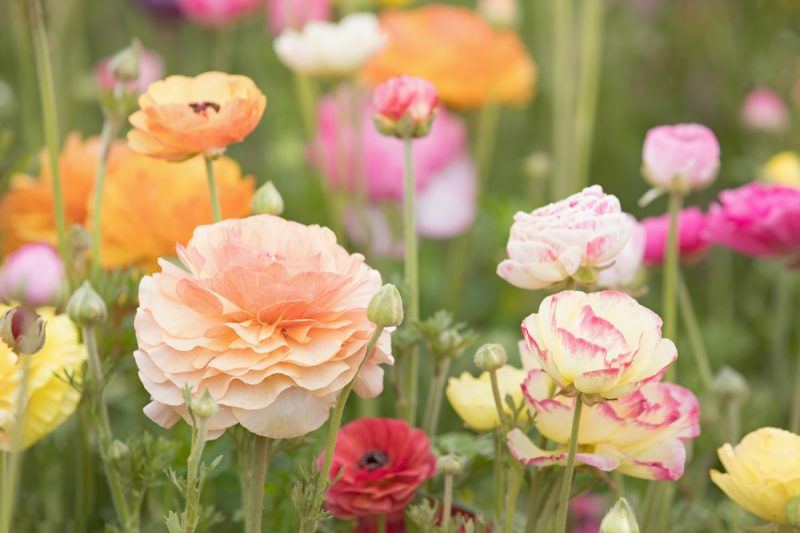Ranunculus, with their rose-like layers and vivid colors, are the showstoppers of any spring garden. From soft pastels to bold jewel tones, these flowers add elegance and drama whether planted in beds, borders, or bouquets. But for many gardeners, the question arises: When do ranunculus bloom, and how can you make that fleeting beauty last longer? Timing is everything when it comes to these cool-season bloomers, and understanding their life cycle is key to unlocking their full potential.
In this guide, you’ll learn not only when ranunculus are likely to bloom in your region, but also the proven methods to extend that bloom time. Whether you’re a beginner planting your first corms or an experienced grower looking to get more out of each season, this article provides all the essential tips for vibrant, long-lasting flowers. Let’s dive into the seasonal secrets that keep ranunculus thriving and blooming longer than ever.
Understanding the Bloom Cycle of Ranunculus

The bloom cycle of ranunculus is closely influenced by temperature, daylight, and planting timing. These cool-season plants start as dormant corms—small, bulb-like storage organs that hold energy for growth. When planted at the right time—usually in fall for mild climates or late winter for colder areas—the corms break dormancy and produce lush, fern-like leaves. This leafy, vegetative phase can last several weeks as the plant builds a strong root system in preparation for flowering.
As spring temperatures gradually warm, ranunculus move into their flowering stage. Buds develop on tall stems and slowly open into the plant’s distinctive, layered blooms. Under ideal conditions, with cool nights and sunny days, blooming can last six to eight weeks. Flowers typically appear around 90 days after planting, although this can vary depending on the variety and local climate.
When temperatures consistently rise above 70–75°F (21–24°C), the plants begin to decline. Leaves yellow, flower production slows, and the plant enters dormancy. At this point, energy flows back into the corms underground, preparing them for the next growth cycle. Knowing this full cycle—from dormancy through bloom and back—is crucial for timing planting and care to enjoy the longest, healthiest flowering season possible.
When Do Ranunculus Bloom in Different Regions?
Ranunculus bloom times depend largely on regional climate conditions and the timing of planting. In mild, Mediterranean-like climates—such as USDA zones 8 to 10, including parts of California and the southern U.S.—ranunculus are typically planted in the fall months, from October to December. This allows the corms to establish roots during the cooler winter months, leading to an early bloom that can begin as soon as late February and extend through March and April. In these regions, the cooler temperatures and moderate rainfall help prolong the flowering period, often lasting well into early May.
In colder climates, such as USDA zones 5 to 7, fall planting is not advisable due to the risk of freezing soil temperatures. Instead, gardeners start ranunculus corms indoors or in greenhouses during late winter and transplant them outdoors in early spring once the danger of frost has passed. In these areas, blooms usually appear later—between April and June—depending on how early the plants were started and local weather conditions.
Regions with short growing seasons, higher elevations, or unpredictable spring weather may see ranunculus blooming even later. Gardeners in such areas often rely on indoor propagation and careful timing to ensure the plants have enough time to develop before summer heat arrives.
By understanding the typical bloom windows for your region and adjusting planting accordingly, you can enjoy the fullest, longest-lasting display of ranunculus flowers in your garden.
Factors That Influence Bloom Timing
Several key factors affect when ranunculus begin to bloom. Climate plays a major role—cool-season areas often see flowers in late spring, while warmer zones enjoy earlier blooms. Planting time is equally important; ranunculus planted in fall bloom earlier than those planted in late winter or early spring.
Soil temperature also influences growth. Tubers require cool soil (around 50–60°F) to establish roots before blooming. Sunlight exposure is essential, as ranunculus need full sun to develop strong stems and vibrant flowers. Lastly, proper watering and feeding ensures plants stay healthy and on schedule for blooming.
By managing these conditions, gardeners can better predict and enjoy the blooming period of their ranunculus.
Signs Your Ranunculus Are About to Bloom
As ranunculus approach their blooming stage, they exhibit several clear signs that flowering is near. One of the first indicators is vigorous foliage growth—you’ll notice dense, deeply cut leaves forming a lush, healthy mound. Soon after, flower buds begin to emerge from the center of the plant, appearing as small, round green balls on tall stems.
These buds gradually elongate and rise above the foliage, often developing a slight swelling or visible layering that hints at the tightly packed petals inside. As blooming nears, the buds may show subtle hints of color—pinks, yellows, oranges, or whites—depending on the variety.
Cool nights and mild days will encourage steady development. Once buds start forming, flowers usually open within 7 to 14 days, especially if the plant receives full sunlight and consistent moisture.
How Long Do Ranunculus Blooms Last?
Ranunculus blooms are admired not only for their layered beauty but also for their impressive staying power. Under ideal conditions, each individual flower can last 7 to 10 days on the plant, and sometimes even longer if temperatures remain cool and care is consistent. Because the plant produces blooms in succession rather than all at once, a healthy ranunculus plant can offer a blooming period of 4 to 6 weeks, sometimes stretching up to 2 months in favorable climates.
The longevity of blooms depends on several factors. Cool weather is key—ranunculus thrive when temperatures stay between 55°F and 65°F (13–18°C). Once temperatures rise above 70°F (21°C) consistently, bloom production slows, and the plants begin to go dormant. Proper watering, well-drained soil, and deadheading spent flowers can also extend the blooming window by encouraging continuous bud development.
In cut flower arrangements, ranunculus are prized for their vase life. When harvested just as the buds begin to open, they can last up to 10 days in a vase, making them a favorite for florists and gardeners alike. By managing temperature, watering, and timely care, you can make the most of this flower’s natural charm and enjoy its radiant display for as long as possible.
How to Make Ranunculus Blooms Last Longer
To extend the blooming period of ranunculus, it’s essential to create optimal growing conditions and maintain consistent care throughout the season. Start by planting the tubers in well-draining soil and a location that receives full sunlight. Ranunculus thrive in cool weather, so in warmer climates, planting in late fall or early winter helps ensure longer-lasting spring blooms. In cooler areas, plant as soon as the ground is workable in early spring.
Watering deeply but infrequently encourages strong roots without causing rot. Allow the topsoil to dry out slightly between waterings to prevent soggy conditions. Apply a low-nitrogen fertilizer every 2 to 3 weeks once foliage appears to support continuous flowering.
Deadheading—removing spent blooms promptly—redirects the plant’s energy toward producing new flowers rather than forming seeds. Gently trim stems back to a leaf node or strong bud. Regularly inspect plants for pests like aphids or fungal issues that can shorten bloom life, and treat early with organic methods.
For cut flowers, harvest blooms in the early morning when petals are just starting to open. Place them in clean water with flower preservative and keep the vase in a cool, shaded location. With the right care, ranunculus can bloom beautifully for 6 to 8 weeks, bringing vibrant color and elegance to your garden or home.
Cut Flower Tips for Longer Vase Life
Ranunculus make exceptional cut flowers, but proper handling is key to enjoying their beauty for as long as possible indoors. Begin by cutting the blooms early in the morning when they’re most hydrated, ideally when the buds are just starting to open. Use sharp, sanitized scissors or pruners and snip the stems at a diagonal to maximize water absorption.
Remove any leaves that would sit below the water line to prevent bacterial growth. Place the stems immediately in cool, clean water, and use a clean vase with fresh floral preservative if available. Keep the arrangement in a cool room away from direct sunlight, heat sources, and ripening fruit, which emits ethylene gas that can shorten bloom life.
Change the water every two days, re-trimming the stems slightly each time to refresh the cut surface. With these simple steps, ranunculus can last 7 to 10 days in a vase, sometimes even longer depending on the variety and freshness at harvest.
Common Blooming Problems and Solutions
Ranunculus plants can sometimes fail to bloom or produce weak flowers due to a few common issues. One major cause is insufficient sunlight. Ranunculus need full sun to develop strong blooms—without it, flowering may be delayed or minimal. Ensure your planting spot receives at least 6 hours of direct sunlight daily.
Another common problem is poor drainage. If the soil stays too wet, tubers can rot before blooming. Use well-draining soil and avoid overwatering, especially in cooler weather. For potted plants, make sure containers have proper drainage holes.
Incorrect planting time can also affect bloom success. Planting too late in warm climates or too early in cold regions may disrupt the plant’s natural cycle. Always align your planting schedule with your climate zone.
Lastly, nutrient deficiencies, especially low phosphorus levels, can lead to weak or no blooms. Applying a balanced fertilizer every few weeks during the growing season can support healthy flowering. By addressing these common issues early, you’ll enjoy a much longer and more vibrant bloom period.
What to Do After Blooming Ends
Once ranunculus blooms fade and the flowering season concludes, post-bloom care plays a vital role in preparing the plants for future growth or dormancy. Begin by removing all spent flowers and yellowing foliage. This not only keeps your garden tidy but also reduces the risk of pests and disease.
Continue watering the plant lightly until the foliage completely dies back. During this time, the energy from the leaves is being redirected into the tubers for storage. Avoid cutting back green leaves too early, as this can weaken the plant and reduce next year’s blooming potential.
If you live in a region with mild winters, you can leave the tubers in the ground, provided the soil drains well and doesn’t stay too wet. Apply a layer of mulch to protect them from occasional cold snaps.
In colder climates where the ground freezes, it’s best to dig up the tubers once the foliage has fully died back. Clean them gently, let them dry for a few days in a cool, shaded area, and then store them in a dry, breathable container filled with peat moss, sawdust, or vermiculite. Keep them in a cool, dark location until the next planting season.
Proper end-of-season care helps preserve the health of your ranunculus and ensures strong, vibrant blooms year after year.
FAQ: Common Questions About Ranunculus Blooming and Care
When is the best time to plant ranunculus for spring blooms?
The ideal planting time depends on your climate. In warmer or mild climates (USDA zones 8–10), plant ranunculus corms in fall—typically between October and early December—for blooms from late winter to early spring. In colder regions (zone 7 and below), plant in late winter or early spring once the risk of frost has passed, usually around February or March. To ensure timely spring blooming, you can pre-sprout the corms indoors about 4–6 weeks before transplanting.
How long do ranunculus flowers bloom, and how can I extend the bloom period?
Ranunculus typically blooms for about 4 to 7 weeks, depending on the weather and care. To extend the bloom time, grow them in a cool, sunny location with consistently moist but well-drained soil. Remove spent flowers promptly (deadheading) to encourage continued blooming. Regularly feeding with a fertilizer high in potassium or phosphorus also helps support prolonged flowering.
Can ranunculus be grown in pots, and what should I keep in mind?
Yes, ranunculus grows well in containers when planted properly. Choose a pot at least 6–8 inches deep with good drainage holes and use loose, well-draining potting mix. Place the container in full sun, and water when the top inch of soil is dry, avoiding soggy conditions. Once temperatures rise or the plant finishes blooming, you can move the pot to a cooler area or lift and store the corms for reuse.
How can I tell when my ranunculus is about to bloom?
Signs that ranunculus is nearing bloom include stems elongating, small round buds forming at the tips, and leaves turning a richer green. As the buds swell and begin to show color, it’s a strong indication that the flowers will open in just a few days.
Can I save ranunculus corms to replant next year?
Yes, you can store ranunculus corms for future planting. After blooming ends, wait for the foliage to die back naturally. Then, dig up the corms, gently clean off the soil, and let them dry in a shaded, well-ventilated area for 2–3 days. Store them in a cool, dry, and dark place using a cardboard box, fabric bag, or tray filled with peat moss, sawdust, or dry vermiculite to maintain stable humidity and prevent rot.
Conclusion
Ranunculus are a breathtaking addition to any garden, and knowing when they bloom—and how to care for them—makes all the difference. With proper planting, timely care, and simple techniques to extend their flowering, you can enjoy their vivid beauty for weeks on end. Whether in the ground or in a vase, ranunculus offer a lasting burst of charm when given the right attention.






